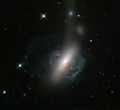Interacting galaxy

Interacting galaxies (colliding galaxies) are galaxies whose gravitational fields result in a disturbance of one another. An example of a minor interaction is a satellite galaxy's disturbing the primary galaxy's spiral arms. An example of a major interaction is a galactic collision.
Satellite interaction
A giant galaxy interacting with its satellites is common. A satellite's gravity could attract one of the primary's spiral arms. Or the satellite could dive in to the primary (e.g. Sagittarius Dwarf Elliptical Galaxy). This could trigger a small amount of star formation.
Galaxy collision

Colliding galaxies are common in galaxy evolution. [2] Due to the extremely tenuous distribution of matter in galaxies, these are not collisions in the normal sense of the word, but rather gravitational interaction. Colliding may lead to merging. This occurs when two galaxies collide and do not have enough momentum to continue traveling after the collision. Instead, they fall back into each other and eventually merge after many passes through each other, forming one galaxy. If one of the colliding galaxies is much larger than the other, it will remain largely intact after the merger; that is, the larger galaxy will look much the same while the smaller galaxy will be stripped apart and become part of the larger galaxy. Through-passes are less disruptive of galaxy shapes than mergers in that both galaxies largely retain their material and shape after the pass.
Galaxy collisions are now frequently simulated on computers, with all the realistic physics, including gravity forces, gas dissipation, star formation and feedback. Dynamical friction slows down galaxy pairs, which may or may not merge at some point, according to the initial relative energy of the orbits. A library of simulated galaxy collisions can be found at the Paris Observatory website: GALMER [3]
-

Galaxu pair Zw I 136.[1]
-

ESO 576-69 is believed to be the nucleus of a former spiral galaxy.[2]
-
.jpg)
The Whirlpool Galaxy with its satellite NGC 5195.
-

The Mice Galaxies.
-
This simulation follows the collision of two spiral galaxies that harbour giant black holes.
- ^ "Galactic soup". ESA/Hubble Picture of the Week. Retrieved 18 August 2014.
- ^ "The messy result of a galactic collision". ESA/Hubble Picture of the Week. Retrieved 29 May 2013.
Galactic cannibalism
Galactic cannibalism refers to the process by which a large galaxy, through tidal gravitational interactions with a companion, merges with that companion, resulting in a larger, often irregular galaxy.
The most common result of the gravitational merger of two or more galaxies is an irregular galaxy of one form or another, although elliptical galaxies may also result.
It has been suggested that galactic cannibalism is currently occurring between the Milky Way and the Large and Small Magellanic Clouds. Streams of gravitationally-attracted hydrogen arcing from these dwarf galaxies to the Milky Way is taken as evidence for this theory.
Galaxy harassment
Galaxy harassment is a type of interaction between a low-luminosity galaxy and a brighter one that takes place within rich galaxy clusters such as Virgo and Coma, where galaxies are moving at high relative speeds and suffering frequent encounters with other systems of the cluster due to the high galactic density of the latter. According to computer simulations, these interactions convert the affected systems into disturbed barred spiral galaxies and produces starbursts on them followed, if more encounters occur, by loss of angular momentum and heating of their gas. Their result would be the conversion of (late type) low-luminosity spiral galaxies into dwarf spheroidals and dwarf ellipticals.[4]
Evidence for this hypothesis has been found studying early-type dwarf galaxies of the Virgo Cluster and finding on them structures such as disks and spiral arms suggesting they are former disk systems transformed by the mentioned interactions.[5]
Notable interacting galaxies
| Name | Type | Distance (million ly) |
Magnitude | Notes |
|---|---|---|---|---|
| Milky Way Galaxy, LMC and SMC | SBc/SB(s)m/SB(s)m pec | 0 | Satellites interacting with their primary | |
| Whirlpool Galaxy (M51) | SAc (SB0-a) | 37 | +8.4 | Satellite interacting with its primary |
| NGC 2207 and IC 2163 | SAc/SAbc | 114 | +11 | galaxies going through the first phase in galactic collision |
| Mice Galaxies (NGC 4676A and NGC 4676B) | S0/SB(s)ab | 300 | +13.5 | galaxies going through the second phase in galactic collision |
| NGC 1097 | SB(s)bc (E6) | 45 | +9.5 | Satellite interacting with its primary |
| Antennae Galaxies (NGC 4038/9) | SAc/SBm | 45 | +10.3 | galaxies going through the third phase in galactic collision |
| NGC 520 | S | 100 | +11.3 | galaxies going through the third phase in galactic collision |
Future collision of the Milky Way with Andromeda
Astronomers have estimated that our galaxy, the Milky Way galaxy, will collide with the Andromeda galaxy in about 4.5 billion years. It is thought that the two spiral galaxies will merge to become an elliptical galaxy[6][7] or perhaps a large disk galaxy.[8]
See also
References
- ↑ "Best View Yet of Merging Galaxies in Distant Universe". ESO Press Release. Retrieved 26 August 2014.
- ↑ space.com 2015-04-21 How the Hubble Space Telescope Changed Our View of the Cosmos-Galactic Collisions Photographs
- ↑ GALMER 27 March 2010
- ↑ Galaxy Harassment
- ↑ More evidence for hidden spiral and bar features in bright early-type dwarf galaxies
- ↑ Hazel Muir (2007-05-14). "Galactic merger to 'evict' Sun and Earth". New Scientist. Archived from the original on 20 April 2014. Retrieved 2014-10-07.
- ↑ Astronomy, June 2008, page 28, by Abraham Loeb and T.J.Cox
- ↑ Junko Ueda et al. "Cold molecular gas in merger remnants. I. Formation of molecular gas disks". The Astrophysical Journal Supplement Series 214 (1). doi:10.1088/0067-0049/214/1/1.
External links
| Wikimedia Commons has media related to Interacting galaxies. |
- Galaxy Collisions
- Galactic cannibalism
- Galactic Collision Simulation
- GALMER: Galaxy Merger Simulations
| ||||||||||||||||||||||||||||||||||
